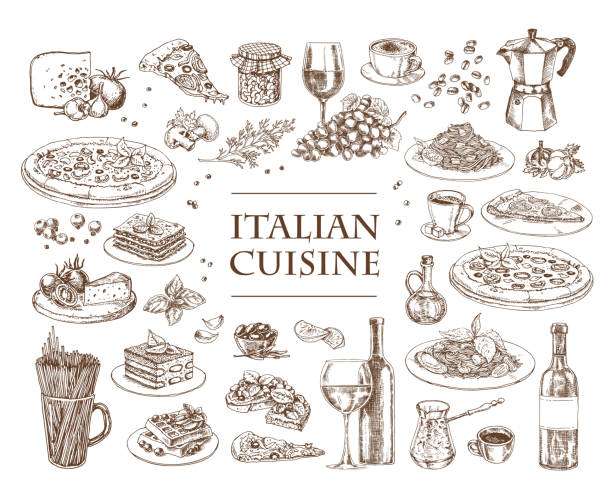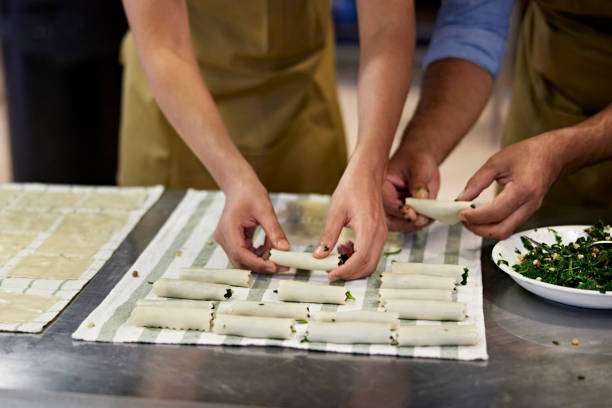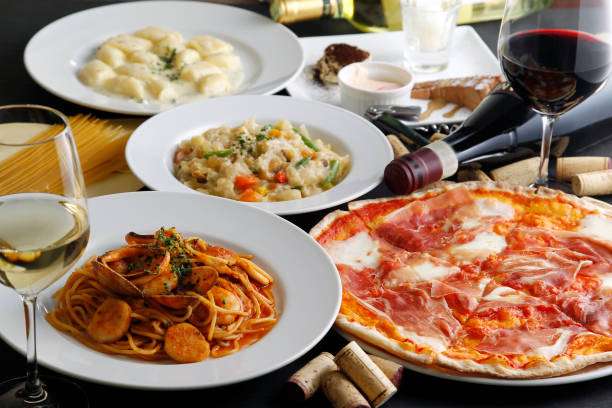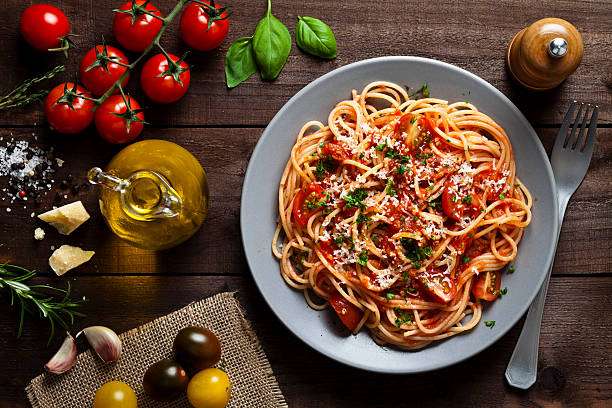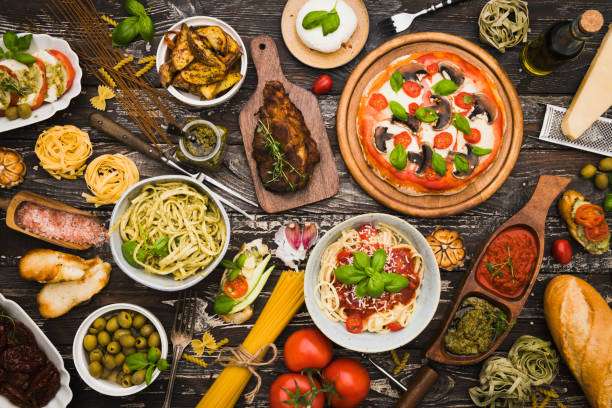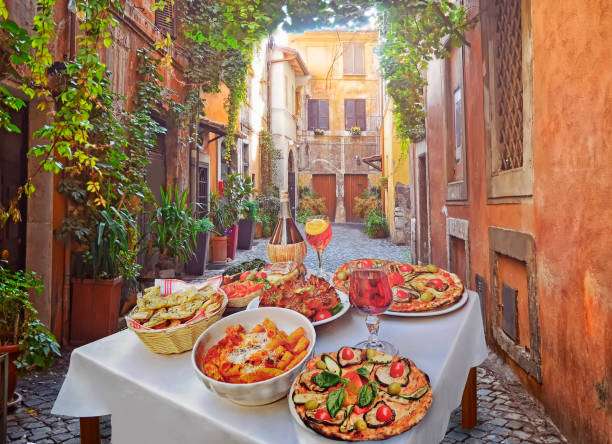How to Create Delicious Italian Recipes with Step by Step Instructions
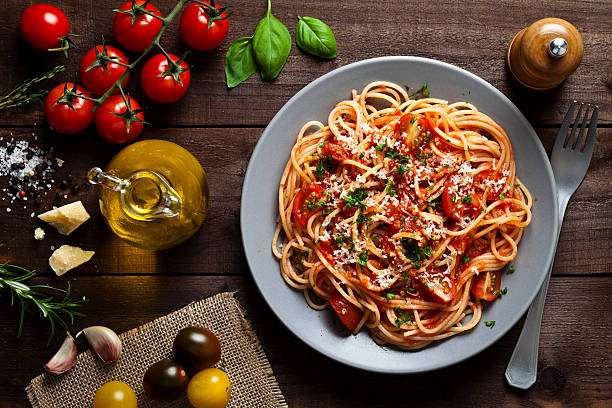
September 12, 2023
Whether you are a master chef or a beginner in the kitchen, Italian cuisine is a classic favorite. It has something for everyone, from the traditional Italian dishes of pasta and risotto to the more creative concoctions of pizza and seafood dishes. No matter what you crave, Italian food has something for everyone. But before you start cooking, it’s important to know what ingredients to use and how to combine them to create delicious Italian recipes. This blog post will provide tips and step-by-step instructions to help you make the most delicious Italian recipes. So let’s get cooking!
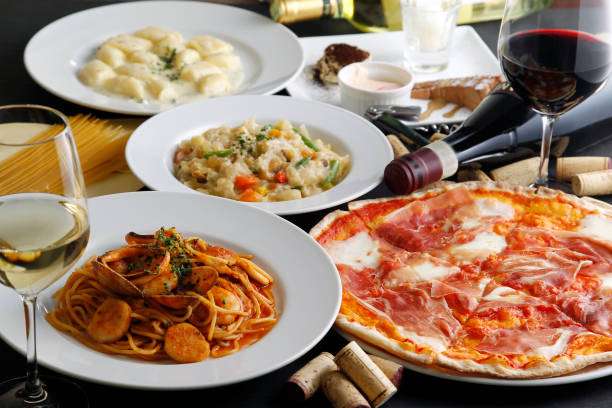
Create Delicious Italian Recipes with Step-by-Step Instructions.
Fixings: 200 g spaghetti, 100 g diced pancetta or guanciale, 2 large eggs, 50 g grated Pecorino Romano and Parmesan cheese, fresh black pepper, and optional parsley (for garnish).
Instructions:
1. Boil some salted water in a large pot, then add the spaghetti and cook until al dente. Reserve about half a cup of the cooking water.
2. Heat a skillet over medium heat and cook the diced pancetta or guanciale for 5-7 minutes or until crispy and golden. Set aside.
3. In a bowl, mix together the eggs, both types of grated cheese, and freshly ground black pepper.
4. Add the cooked pancetta or guanciale to the drained spaghetti and toss to combine.
5. Pour the egg-cheese mixture over the hot pasta and toss evenly. The heat of the pasta will cook the eggs, creating a creamy sauce.
6. Adjust the consistency of the sauce, if needed, by gradually adding in some reserved cooking water.
7. Garnish with chopped fresh parsley, if desired, and serve.
Ingredients for Margherita Pizza: dough for pizza (store-bought or homemade), 1/2 cup fresh mozzarella slices, fresh basil leaves, extra-virgin olive oil, salt, and black pepper.
Instructions:
1. Preheat the oven to its highest temperature (typically around 475°F or 245°C). Place a pizza stone in the oven while it heats up, if using one.
2. Roll out the pizza dough on a floured surface into a circle approximately 12 inches in diameter.
3. Place the rolled-out dough on a pizza peel or an overturned baking sheet lined with parchment paper. Use cornmeal or a well-floured pizza stone to prevent sticking, if needed.
4. Spread the tomato sauce evenly over the pizza dough, leaving a small border for the crust around the edge.
5. Arrange the mozzarella slices over the sauce. Tear the fresh basil leaves and scatter them over the cheese.
6. Top with a drizzle of extra-virgin olive oil. Season with a pinch of salt and freshly ground black pepper.
7. If using parchment paper, carefully transfer the pizza onto the preheated pizza stone or directly onto a baking sheet. Bake for 10-12 minutes, or until the cheese is bubbly and slightly browned and the crust is golden.
8. Let it cool for a minute before serving. Enjoy!
Method 1: Spaghetti Carbonara
Fixings:
200 grams of spaghetti, 100 grams of pancetta or guanciale, diced, two large eggs, 50 grams of grated Pecorino Romano cheese, 50 grams of grated Parmesan cheese, freshly ground black pepper, and chopped fresh parsley (for garnish, optional)
Heat the Pasta Up: Bring salted water to a boil in a large pot. Cook the spaghetti according to the package directions until al dente. After draining the spaghetti, keep about 1/2 cup of the water that was used to cook it.
Cook the Pancetta/Guanciale: Heat a large skillet to medium heat while the pasta cooks. Cook the diced pancetta or guanciale for 5-7 minutes, or until crispy and golden brown. Eliminate from intensity and put away.
Make the mixture of eggs: Mix the eggs, grated Pecorino Romano, and grated Parmesan cheese in a bowl. Sprinkle generously with freshly ground black pepper to taste.
Serve the pasta with the pancetta/guanciale: Return the depleted pasta to the pot it was cooked in. Add the cooked pancetta or guanciale and throw to consolidate.
Add the mixture of eggs: Pour the egg-cheese mixture quickly over the hot pasta. Throw enthusiastically to equitably cover the pasta. The intensity from the pasta will cook the eggs, making a smooth sauce.
Change Consistency: If the sauce is too thick, gradually add some of the pasta cooking water you saved until the desired consistency is reached.
Serve: If desired, top the spaghetti carbonara with freshly chopped parsley. Serve right away.
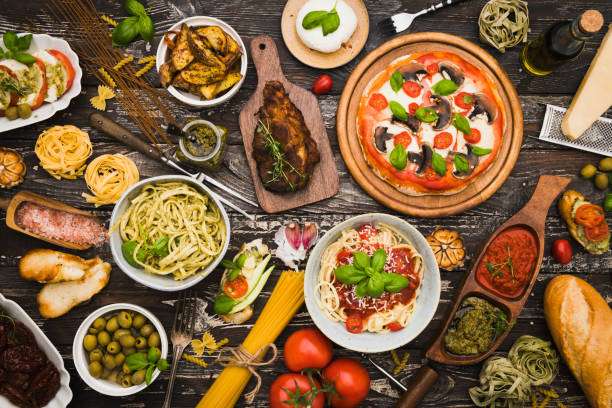
2nd recipe: Margherita Pizza:
Dough for pizza (store-bought or homemade), 1/2 cup fresh mozzarella cheese, sliced, fresh basil leaves, extra-virgin olive oil, salt, and freshly ground black pepper
Preheat the Stove: Preheat your stove to the most noteworthy temperature it can go (normally around 475°F or 245°C). Place a pizza stone in the oven while it heats up if you have one.
Roll the Dough Out: Carry out the pizza batter on a floured surface into a circle, around 12 creeps in width.
Get the Pizza Ready: Put the carried out mixture on a pizza strip or an upset baking sheet fixed with material paper. Use cornmeal or a well-floured pizza stone to prevent sticking if you're using one.
Add Pureed tomatoes: Leave a small border for the crust around the edge of the pizza dough as you spread the tomato sauce evenly over it.
Add Mozzarella and Basil: Sprinkle the sauce evenly over the sliced mozzarella. Tear new basil leaves and disperse them over the cheddar.
Olive oil drizzled over it: Top with a drizzle of extra-virgin olive oil. Season with a spot of salt and newly ground dark pepper.
Heat the Pizza: If you used parchment paper, carefully transfer the pizza to the preheated pizza stone or directly onto a baking sheet. Bake for 10 to 12 minutes, or until the cheese is bubbly and slightly browned and the crust is golden.
Serve: Allow it to cool for a minute after taking it out of the oven. Serve your delicious Margherita pizza by slicing it.
What ingredients do I need to create delicious Italian recipes?
To create truly delicious Italian cuisine, you'll need to have some key ingredients on hand. Extra virgin olive oil is a must, as well as garlic, tomatoes tomato sauce, a variety of pasta, and of course various cheeses such as parmesan, pecorino Romano, mozzarella, and ricotta. Other essentials include basil, oregano, onions, prosciutto, balsamic vinegar, red and white wine, flour, eggs, capers and olives, anchovies, pine nuts, fresh mozzarella, and risotto rice. Pancetta or guanciale, and fresh seafood can also be very useful if you are making a specific regional dish. With these ingredients, you can create countless Italian recipes that are sure to please!
To create delicious Italian recipes, you'll want to have a selection of key ingredients commonly used in Italian cuisine. Here's a list of essential ingredients you may need:
Olive Oil: Extra virgin olive oil is a staple in Italian cooking and is used for sautéing, dressing salads, and drizzling over finished dishes.
Garlic: Garlic is a fundamental flavor in Italian cuisine and is used in a wide variety of dishes.
Tomatoes: Fresh tomatoes, canned tomatoes, and tomato sauce are crucial for making pasta sauces, soups, and many other Italian dishes.
Pasta: Various types of pasta like spaghetti, fettuccine, penne, and more are commonly used in Italian recipes.
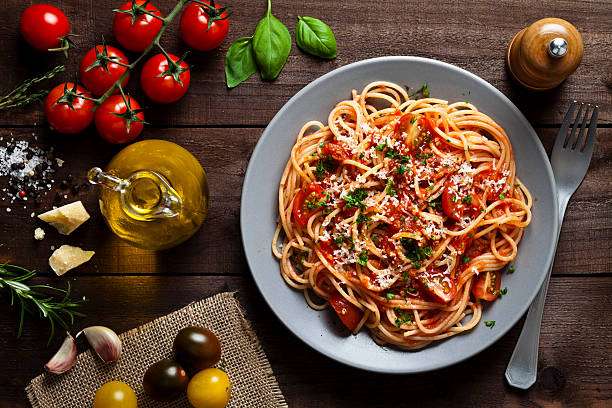
Cheeses: Parmesan, Pecorino Romano, mozzarella, and ricotta are popular cheeses in Italian cuisine. They're used in pasta dishes, pizzas, and salads.
Basil: Fresh basil leaves are used to add a fresh and aromatic element to many Italian dishes.
Oregano: Dried oregano is commonly used in pasta sauces, pizza, and many other Italian recipes.
Onions: Onions are used as a flavor base in many Italian recipes, especially in sauces and soups.
Prosciutto: This thinly sliced, cured ham is often used in antipasti, salads, and pasta dishes.
Balsamic Vinegar: This vinegar is used for salad dressings, marinades, and as a flavor enhancer in various dishes.
Wine (Red and White): Both red and white wines are used in Italian cooking, often for deglazing pans and adding flavor to sauces.
Flour: Used for making pasta, pizza dough, and various bread-based dishes.
Eggs: Eggs are used in making pasta dough, as well as in desserts like tiramisu.
Capers and Olives: These add a salty and tangy flavor to many Italian dishes, especially in Mediterranean-inspired recipes.
Anchovies: These are used sparingly to add a deep umami flavor to dishes.
Pine Nuts: These are used in pesto and various other dishes for their unique texture and flavor.
Fresh Mozzarella: This soft, creamy cheese is commonly used in salads, pizza, and various other dishes.
Risotto Rice: Arborio or Carnaroli rice are essential for making creamy Italian risotto.
Pancetta or Guanciale: These cured meats are used to add rich, savory flavors to pasta dishes like Carbonara and Amatriciana.
Fresh Seafood: Italy has a rich tradition of seafood dishes, so having access to fresh fish and shellfish can be crucial.
Remember, while these are common ingredients, Italian cuisine is incredibly diverse and can vary widely from region to region. Depending on the specific dish you're interested in, you may need additional or specialized ingredients. Enjoy your Italian culinary adventures!
How do I know which Italian recipes are the most delicious?
To find the tastiest Italian recipes, look for reputable sources, stick to traditional ingredients and cooking techniques, and consider the flavor balance. Additionally, read reviews and comments from people who have tried the recipe, and pay attention to its cultural significance. Ultimately, the most delicious recipe for you will depend on your personal tastes and cooking abilities. Have fun exploring Italian cuisine!
Determining the "most delicious" Italian recipes can be subjective and depends on personal taste preferences. However, there are a few factors you can consider to find highly regarded recipes:
Reputation and Ratings: Look for recipes from reputable sources like established food websites, renowned chefs, or popular cookbooks. Check for user ratings and reviews to get an idea of how well-received the recipe is.
Authenticity: Authentic Italian recipes often have a balance of simple, high-quality ingredients and traditional cooking techniques. Look for recipes that stick to these principles.
Ingredient Quality: The quality of ingredients can greatly affect the taste of a dish. Fresh, seasonal, and high-quality ingredients are key in Italian cuisine.
Technique and Instructions: A well-written recipe should provide clear, detailed instructions that guide you through each step. Look for recipes that explain techniques and provide helpful tips.
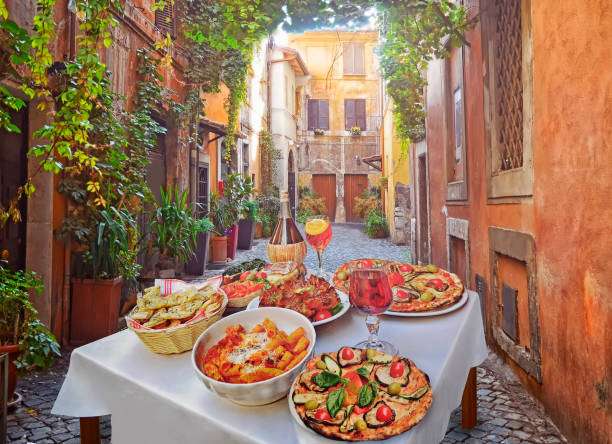
Balance of Flavors: Italian cuisine is known for its emphasis on balance. A good recipe will have a harmonious blend of flavors, with no single element overpowering the others.
Reviews and Comments: Read reviews and comments from people who have tried the recipe. They often share their experiences and may offer tips or modifications.
Cultural Significance: Some Italian dishes have cultural or regional significance, and recipes associated with particular areas or traditions may be particularly revered.
Personal Taste: Consider your own taste preferences. Do you prefer creamy, tomato-based, or olive oil-based sauces? Are you a fan of dishes with lots of herbs, or do you prefer simpler flavors?
Ultimately, the "most delicious" Italian recipe for you will be one that aligns with your own palate and cooking abilities. Don't be afraid to try different recipes and adapt them to your liking. Enjoy the process of exploring Italian cuisine!
Are there any online resources to help me make Italian recipes?
There are plenty of online resources that can help you make delicious Italian recipes. Popular sites such as AllRecipes, Food Network, Epicurious, BBC Good Food, and Serious Eats all have an Italian section with step-by-step instructions. Moreover, apps such as Yummly, Tasty, and Kitchen Stories have a wide range of Italian recipes. You can also check out cookbooks from Google Books, Amazon Books, and other sources. Lastly, social media platforms like Pinterest, Instagram, and Facebook have many Italian food-focused accounts and groups where you can find recipes, tips, and inspiration. Make sure to read the ratings and reviews before trying a recipe, and be sure to explore different sources to find the perfect recipe for you. Enjoy your Italian cooking experience!
Absolutely! There are many online resources available to help you make Italian recipes. Here are some popular websites, blogs, and platforms where you can find a wide range of Italian recipes along with step-by-step instructions:
AllRecipes (Italian Section): AllRecipes Italian Recipes
Food Network (Italian Section): Food Network Italian Recipes
Epicurious (Italian Section): Epicurious Italian Recipes
BBC Good Food (Italian Section): BBC Good Food Italian Recipes
Serious Eats (Italian Section): Serious Eats Italian Recipes
Jamie Oliver's Website: Jamie Oliver Italian Recipes
Simply Recipes (Italian Section): Simply Recipes Italian Recipes
Apps like "Yummly," "Tasty," and "Kitchen Stories" have a wide variety of Italian recipes.
Cookbook Websites: Websites like Google Books and Amazon Books allow you to preview and purchase Italian cookbooks.
Social Media Platforms: Platforms like Pinterest, Instagram, and Facebook have many Italian food-focused accounts and groups where you can find recipes, tips, and inspiration.
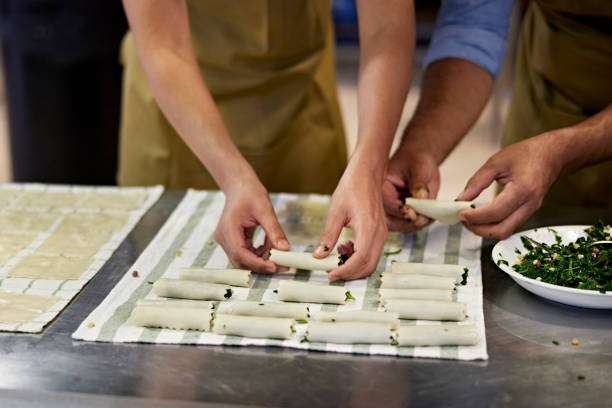
Remember to always check the reviews and ratings of recipes and feel free to explore different sources to find recipes that suit your taste and cooking style. Happy cooking!
Summary
- Italian cuisine is a classic favorite with something for everyone
- Before cooking, it's important to know what ingredients to use and how to combine them
- The blog post provides tips and step-by-step instructions to make delicious Italian recipes
- Recipe for Spaghetti Carbonara includes diced pancetta or guanciale, eggs, grated Pecorino Romano and Parmesan cheese, and optional parsley
- Method for Margherita Pizza includes pizza dough, tomato sauce, mozzarella slices, basil leaves, olive oil, salt, and pepper
- Instructions for both recipes are provided in the blog post.
As we all eagerly await the thrilling Monday night NFL matchup between the Buffalo Bills and New York Jets, why not add some Italian flavor to your game night?
At Sanjay Lathiya's Italian Recipes (https://www.sanjaylathiya.com), we're all about adding a dash of Italian zest to your life. And what better way to enjoy the game than with our delicious, authentic Italian dishes?
Just like the Bills are the team to beat in the AFC East, our "403 - FORBIDDEN" is the dish to beat in the world of Italian cuisine. It's the perfect companion for your game night, just like Aaron Rodgers is for the Jets. So, while our superfan Aaron Rodgers is leading cheers in the stands, you can lead cheers at home with our mouthwatering "403 - FORBIDDEN". As SportsLine's model simulated the Jets vs. Bills game, we've been simulating the perfect blend of flavors for your palate. And trust us, our "403 - FORBIDDEN" is a sure bet!
So, get ready for a thrilling season of NFL and a delicious journey of Italian cuisine with Sanjay Lathiya's Italian Recipes. Because when it comes to great food and great football, why should you have to choose?
#NFL #ItalianCuisine #GameNight #403FORBIDDEN #SanjayLathiyaItalianRecipes
FAQS

1. What ingredients do I need to create Italian recipes?
Answer: Extra virgin olive oil, garlic, tomatoes and tomato sauce, a variety of pasta, parmesan, pecorino Romano, mozzarella, ricotta, basil, oregano, onions, prosciutto, balsamic vinegar, red and white wine, flour, eggs, capers, olives, anchovies, pine nuts, fresh mozzarella, and risotto rice, Pancetta or guanciale, and fresh seafood.
2. Are there any online resources to help me make Italian recipes?
Answer: Yes, there are numerous online resources available such as AllRecipes, Food Network, Epicurious, BBC Good Food, and Serious Eats. Additionally, there are apps such as Yummly, Tasty, and Kitchen Stories with a wide range of Italian recipes. Cookbooks from Google Books, Amazon Books, and other sources can also be helpful. You can also explore social media platforms like Pinterest, Instagram, and Facebook for Italian recipes and inspiration.
3. How do I know which Italian recipes are the most delicious?
Answer: Look for reputable sources, stick to traditional ingredients and cooking techniques, and consider the flavor balance. Read reviews and comments from people who have tried the recipe and pay attention to its cultural significance. Ultimately, the most delicious recipe for you will depend on your personal tastes and cooking abilities.
4. What type of Italian dishes can I make with the ingredients mentioned?
Answer: You can make a variety of Italian dishes such as pastas, risottos, pizzas, and other classic recipes. Additionally, you can also explore regional dishes that use the listed ingredients.
5. Do I need special equipment to make Italian recipes?
Answer: No, you don’t necessarily need special equipment to make Italian recipes. However, having a few basics such as a good knife, cutting board, nonstick skillet, and pot can make the process easier. Additionally, a food processor or blender can be helpful for certain recipes.
